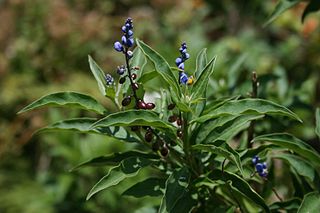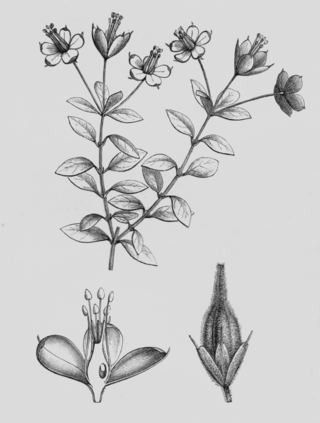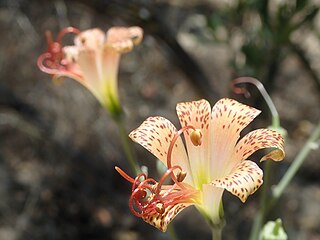
Alzatea verticillata is a small flowering tree, native to the Neotropics. It inhabits moist submontane forests from Costa Rica and Panama in Central America south to Peru and Bolivia in tropical South America. It is the sole species of genus Alzatea and family Alzateaceae.

Calceolaria, also called lady's purse, slipper flower and pocketbook flower, or slipperwort, is a genus of plants in the family Calceolariaceae, sometimes classified in Scrophulariaceae by some authors. This genus consists of about 388 species of shrubs, lianas and herbs, and the geographical range extends from Patagonia to central Mexico, with its distribution centre in Andean region. Calceolaria species have usually yellow or orange flowers, which can have red or purple spots. The Calceolaria Herbeohybrida group, also called C. herbeohybrida Voss, is a group of ornamental hybrids known only in cultivation, called florists' slipperwort.

Bletia is a genus of about 30 species of orchids, almost all of which are terrestrial; some are occasionally lithophytic or epiphytic. It is named after Spanish botanist and pharmacist Don Luis Blet. The genus is widespread across Florida, Mexico, Central America, the West Indies, and South America as far south as Argentina.

Lardizabala is a monotypic genus of flowering plants. The sole species in the genus is Lardizabala biternata, known as Lardizabala or Zabala fruit. This species is an evergreen liana, native to temperate forests of central and southern Chile. It is grown for its edible fruits and ornamental flowers.

Nierembergia, common name cupflower, is a genus of plants in the nightshade family. It is named after the Spanish Jesuit and mystic Juan Eusebio Nieremberg (1595-1658).

Toxicodendron striatum is a South American poisonous tree in the family Anacardiaceae. It is commonly called manzanillo and grows in the tropical rain forests on low elevation slopes.

Iriartea is a genus in the palm family Arecaceae. It is native to Central and South America. The best-known species – and probably the only one – is Iriartea deltoidea, which is found from Nicaragua, south into Bolivia and a great portion of Western Amazonian basin. It is the most common tree in many forests in which it occurs.

Axinaea is a genus of flowering plants in the family Melastomataceae. As of 2012, there are at least 42 species. They are small trees and shrubs. They are native to the Americas; almost all are found in the Andes.
Huertea cubensis is a species of plant in the family Tapisciaceae. It is found in Cuba, the Dominican Republic, and Haiti.

Monnina is a genus of flowering plants in the family Polygalaceae. There are 150 to 200 species distributed throughout the Americas from the United States to Patagonia. It was named after José Moñino, 1st Count of Floridablanca.

Sessea is a genus of 19 accepted species of shrubs, small trees and climbers belonging to the subfamily Cestroideae of the plant family Solanaceae. The flowers of Sessea are so similar to those of Cestrum that the genera cannot usually be told apart, unless the plants are in fruit. Then their distinguishing characteristics become immediately apparent; plants of the genus Sessea bearing dehiscent capsules dispersing winged seeds, while those belonging to the genus Cestrum bear juicy berries containing prismatic seeds. The flowers of both Sessea and Cestrum have tubular corollas that are long exserted from small calyces.

Heteranthera is a genus of aquatic plants in the water hyacinth family, Pontederiaceae, known generally as mud plantains. Species of this genus are native to tropical and subtropical America and Africa. They live in the water or in wet soils. They produce leaves on long petioles and some are cultivated for their attractive flowers. Leaves are of two types - linear and submerged or orbicular and floating. Some species have cleistogamic flowers.

Bowlesia incana is a species of flowering plant, known by the common name hoary bowlesia, in thefamily Apiaceae. It is native to South America and the southeastern and southwestern United States as far north as Washington. It can also be found in Pakistan and New Zealand as an introduced species. It grows in many types of habitat. This is a small annual herb growing thin, spreading stems less than 60 centimeters long. The leaves are borne on long petioles and have multilobed rounded or kidney-shaped blades less than 3 centimeters wide. The green herbage of the plant is coated in fine white hairs. The inflorescences of yellow-green flowers appear in the leaf axils. The tiny inflated fruit is only 2 millimeters wide.

Porlieria is a genus of flowering plants in the caltrop family, Zygophyllaceae. Species within this genus are shrubs or small trees of dry subtropical regions. The generic name honours Spanish ambassador Don Antonio Porlier de Baxamar.

Fernandezia is a genus of flowering plants from the orchid family, Orchidaceae. It contains about 30-40 species, native to northern South America, Central America, and southern Mexico.

Clinanthus is a genus of bulbous plants in the family Amaryllidaceae. It is found in western South America, including Ecuador, Peru, Bolivia, north Chile and north west Argentina.

Rhynchotheca is a genus of flowering plants belonging to the family Geraniaceae. Its native range is Ecuador to Peru.

Alstroemeria versicolor is a species of plant in the family Alstroemeriaceae. It is a perennial herb endemic to Chile, where it is distributed between the Santiago Metropolitan and Araucanía regions.

Alstroemeria revoluta is a species of plant in the family Alstroemeriaceae. It is a perennial herb endemic to Chile, where it is distributed between the Valparaíso and Araucanía regions.

















